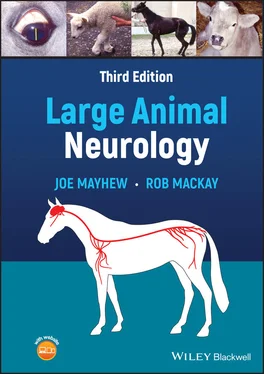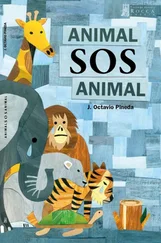Dysphagia caused by lesions of the basal nuclei occurs in horses in western North America as a result of yellow star thistle or Russian knapweed poisoning causing nigropallidal encephalomalacia, but can also be caused by focal lesions of S. neurona protozoal myeloencephalitis or migrating helminth parasites. Prehension and mastication are impaired, but affected animals can usually swallow. Other signs of brain disease may be mild or absent.
The signs of dysphagia seen with medullary lesions depend on the specific cranial nerve nuclei affected. There are usually other asymmetric signs of medullary disease such as somnolence, limb weakness and ataxia, and other cranial nerve signs particularly from any involvement of the vestibular and facial nuclei. 9,10Specific causes include S. neurona protozoal myeloencephalitis, migrating metazoan parasites, and trauma to the back of the head with medullary hemorrhage. Diffuse brain diseases with a medullary component, such as the toga‐ and flavi‐viral encephalitides, rabies, meningitis, locoweed poisoning, and hepatoencephalopathy, can include dysphagia as part of the clinical syndromes.
Bilateral involvement of the motor branches of the trigeminal nerve causes paralysis and eventual atrophy of the masseter muscles and of the temporal, pterygoid, and distal belly of the digastricus muscles ( Chapter 12). The resulting weak jaw tone causes difficulty in mastication and allows the tongue to hang from the mouth. Unilateral trigeminal paralysis does not cause significant dysphagia but may result in slight deviation of the jaw, initially away from the affected side. Damage to the sensory branches of the trigeminal nerve (CN Vs) supplying the face, mouth, and rostral tongue does not produce severe dysphagia but may cause food accumulation in the cheeks and laceration of the tongue by teeth.
Paralysis of the lips due to facial nerve (CN VII; Chapter 14) damage on one side causes minor problems in prehension of food, perhaps only with pasture and grain. Food‐stained saliva may dribble from the commissure of the lips, and food often adheres to the gums and lips. Bilateral facial paralysis does however cause marked problems in prehending forages and dry grain, but slurries of food are usually handled reasonably well.
Marked bilateral paralysis of the pharyngeal and palatine muscles innervated by cranial nerves IX, X, and XI makes swallowing impossible. Attempts at eating are followed by choking, dorsal displacement of the soft palate, and food and saliva exiting the nostrils in horses and the mouth in other herbivores. Unilateral paralysis causes less severe signs. Aspiration of food may lead to necrotic bronchopneumonia and is particularly likely if there is concurrent paralysis of the larynx due to damage of the laryngeal fibers of the vagus nerve. In affected horses, collapse of the atonic pharyngeal walls, displacement of the soft palate, and poor abduction of the vocal folds cause abnormal respiratory noises, especially during exercise and during attempts at swallowing.
Damage to CN Xll, the hypoglossal nerve, causes lingual paralysis and eventual atrophy. This is accompanied by quidding of poorly chewed food and drooling of saliva, with poor tongue retraction only if bilateral. This may occur with the ingestion of young bamboo plants by horses. 11
Various combinations of cranial nerve deficits may have synergistic effects in producing dysphagia. Examples of these combinations are facial and lingual paresis, motor trigeminal and lingual paresis, and sensory trigeminal and vagal motor deficits.
Some diseases (and the CN involvement) resulting in dysphagia include guttural pouch mycosis (IX, X, XI, XII), ruptured rectus capitus ventralis muscle (IX, X, XI), fractured hyoid bone (V or Xll depending on the site of fracture), excessive traction on the tongue (XIl), and retropharyngeal lymph node abscessation (IX, X, and Xll). 12–16Affected horses usually have other signs of the primary disease in addition to dysphagia. Polyneuritis equi can cause dysphagia by affecting any or all of cranial nerves V, VII, IX, X, XII. 17–19Dysphagia, along with laryngeal paralysis, is also a common sequel to chronic lead poisoning. Seven of 16 horses with Lyme neuroborreliosis had pharyngeal dysphagia, five had tongue weakness, and four had facial paralysis associated variously with meningoencephalitis, radiculitis, or neuritis affecting any or all of CNs VII, IX, X, and XII. 20
Botulism is associated with generalized paresis of striated muscles, including those of prehension, mastication, and swallowing. 21–26The toxins produced by Clostridium botulinum block neuromuscular transmission by interfering with the action of acetylcholine. Early clues of dysphagia in botulism cases can be slow and relatively quiet prehension and mastication, prolonged eating times, and excess saliva in the mouth and on the tongue which is readily grasped and held, albeit very slimy ( Figure 15.1).

Figure 15.1 Esophageal choke must be the most common cause of dysphagia in large animals, particularly associated with anhydrous feed in horses, and bulky forage items in cattle. Botulism and guttural pouch mycosis are also accompanied by pharyngeal choke with nasal and even oral return of food, saliva, and sometimes purulent exudate. With botulism (A and B), the food returning is usually not accompanied by exudate until a chronic state is reached when there is secondary necrotic respiratory disease. Quiet, slow and cumbersome chewing may be characteristic in some cases (A), and with oral dysphagia in botulism cases the material is usually soaked with saliva making the mouth and tongue extremely wet (B) and slippery to examine. Perhaps surprisingly, unilateral guttural pouch catarrh, empyema, and mycosis (C) often cause degrees of pharyngeal paralysis with mucopurulent exudate (and sometimes blood) accompanying the chewed food appearing at the nares.
The neurotoxin produced by Clostridium tetani facilitates firing of final motor neurons throughout the CNS. This toxin has a slight predilection for the medullary nuclei that control eating. Thus, besides generalized muscle tetany, there is hypertonicity of the muscles that control eating, particularly the masseter muscles, resulting in trismus or lockjaw.
A high prevalence of dysphagia (milk aspiration) occurred in full‐term, unrelated, neonatal foals on a breeding farm in Pennsylvania close to unconventional natural gas (hydraulic fracturing, also called fracking) operations. 2Of 28 foals born over three years, there were 17 (61%) foals affected with dysphagia for which no specific cause could be determined. Fourteen of the affected foals regained swallowing ability over a median of 11 days, although three foals required hand rearing having never gained suckling ability. There was strong toxicologic evidence for a role of environmental contamination by polycyclic aromatic hydrocarbons, and the problem of neonatal dysphagia was eliminated by the installation of a water filtration and treatment system. 2
Myopathy involving pharyngeal and other muscles, such as caused by doxycycline and other toxicities in ruminants, can include dysphagia in the overall syndrome. 27, 28
Finally, equine dysautonomia or grass sickness is an important differential in animals with dysphagia in endemic areas. Affected horses drop food, drool saliva, reflux through the nostrils, and have difficulties in swallowing. The exact mechanism causing dysphagia in grass sickness has not been clearly defined. 29–31
1 1 Sitton M, Arvedson J, Visotcky A, et al. Fiberoptic endoscopic evaluation of swallowing in children: feeding outcomes related to diagnostic groups and endoscopic findings. Int J Pediatr Otorhinolaryngol 2011; 75(8): 1024–1031.
Читать дальше













